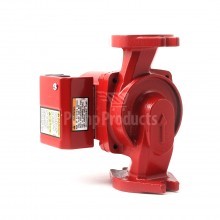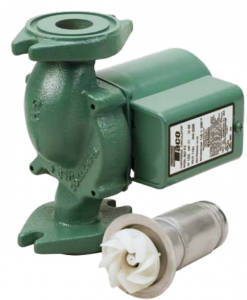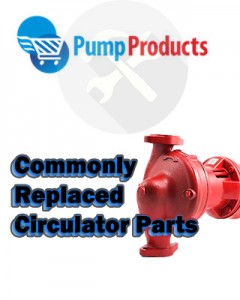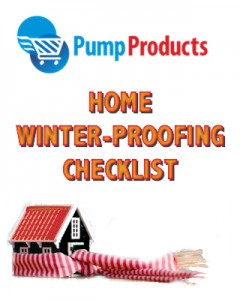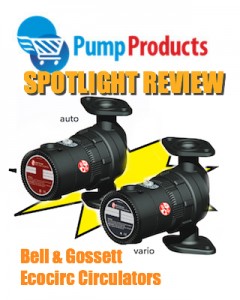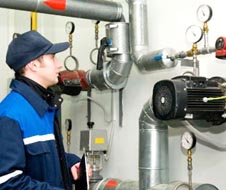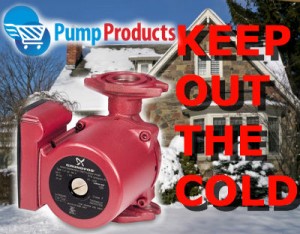-
Bell & Gossett LR Series Circulator Pumps Buyers Guide & Review
July 30, 2019The Bell & Gossett Series LR circulator pump is used for water circulating applications in hydronic and solar systems. These pumps are designed to pump liquids compatible with their iron, bronze or stainless steel body constructions. The Series LR Circulator features maintenance-free system liquid lubricated bearings, non-overloading permanent split capacitor motor with impedance protection, and quiet operation. BELL & GOSSETT LR SERIES CIRCULATOR PUMPS Model Comparison Chart Model Connection Size HP Voltage Phase GPM Max. Head LR20WR 3/4", 1", 1-1/4", 1-1/2" 1/15 115 1 36 12' LR15BWR 3/4", 1-1/4", 1-1/2" 1/12 115 1 37 12' PERFORMANCE CURVES MATERIALS OF CONSTRUCTION SPECIFICATIONS BROCHURE Bell & Gossett LR Series Circulator Pump Brochure INSTALLATION MANUAL Bell & Gossett LR Series Circulator Pump Installation Manual REPAIR PARTS Bell & Gossett LR Series Circulator Pump Repair Parts Pump Products application engineers are standing by to help you find the right pump, as well as to provide price quotes, stocking availability and shipping information. Call our toll free number 1-800-429-0800 to speak to an expert today.
-
Bell & Gossett NRF Series Circulator Pumps Buyers Guide & Review
July 30, 2019The Bell & Gossett NRF series is residential or light commercial, maintenance free, axial flanged, in-line, cast iron, wet rotor, circulation pumps designed for hydronic heating systems. Features High starting torque provides years of trouble-free start-ups Unique B&G DuraGlide Bearing System assures whisper-quiet, maintenance-free operation Closed impeller design improves operating efficiency Backed by B&G's representatives and a great 3-year warranty BELL & GOSSETT NRF SERIES CIRCULATOR PUMPS Model Comparison Chart Model Connection Size HP Voltage Phase GPM Max. Head NRF-22 3/4", 1", 1-1/4", 1-1/2" 1/25 115 1 22 15' NRF-9F/LW 3/4", 1", 1-1/4", 1-1/2" 1/40 115 1 13 8' NRF-25 3/4", 1", 1-1/4", 1-1/2" 1/15 115 1 24 19' NRF-33 3/4", 1", 1-1/4", 1-1/2" 1/15 115 1 37 12' PERFORMANCE CURVES DIMENSIONS SPECIFICATIONS DIAGRAM TROUBLESHOOTING USER MANUAL Bell & Gossett NRF Series Circulator Pump User Manual INSTALLATION MANUAL Bell & Gossett NRF Series Circulator Pump Installation Manual REPAIR PARTS Bell & Gossett NRF Series Circulator Pump Repair Parts Pump Products application engineers are standing by to help you find the right pump, as well as to provide price quotes, stocking availability and shipping information. Call our toll free number 1-800-429-0800 to speak to an expert today.
-
Inspector Pumphead’s Classroom: How To Change a Circulator Pump Cartridge
November 2, 2017Welcome to another exciting edition of Inspector Pumphead's Classroom! In this feature, we'll be talking about various small, simple pump "How-To's" that any homeowner or facilities manager can tackle. Next up: How to Replace the Cartridge on a Taco 007 Circulator Pump. As the name suggests, circulator pumps are used to keep hot water circulating throughout your water system so that it is immediately available at point of use. For those of us who live in colder climates, the coming winter months are a particularly annoying time to have to wait for water at the sink or tub to heat up. The presence of a circulator pump ensures that hot water is always readily available. The Taco 007 is built for quiet operation in hydronic heating, radiant heating, hydro-air fan coils, indirect water heaters, chilled fresh water and domestic water circulating systems. The cartridge style design means the actual circulating mechanism is contained in an easily serviceable or replaceable single unit. It is perhaps the most popular cirulator on the market and plenty are always available in stock. In the video below, Pump Products application engineer Nick, who I have personally trained, will walk you through the process of replacing the cartridge, using the Taco 007-F5 pump and the proper Taco replacement cartridge (the cartridge package should also include a replacement gasket and spare bolts as well). You can also purchase the full suit of Taco Repair parts. You can also continue reading below for a written breakdown. Items and Materials The only tool you'll need is a hexagonal Allen key (or Allen wrench). Make sure you have the replacement cartridge handy as well. Steps --Turn off the water flowing through your system. You do not need to remove the pump base outlets from the piping. --Identify the four casing bolts. --One by one, use the proper Allen key to loosen the bolts. --Remove the bolts. --Remove the motor casing from the volute. Inside the motor casing you will see the cartridge. --The cartridge should be solidly in place. Tug gently but firmly until the cartridge is out of the casing. --Discard used cartridge. --Take the replacement cartridge and firmly insert into the volute. --Firmly place the replacement rubber gasket into the lip of the volute base. The gasket is important for creating a seal. --Line up the base plate and the volute to the base and connect them. Be sure to match up the bolt holes. --Insert the bolts and tighten only until each is roughly equally snug. Uneven tightening could cause leaks in one area. --Complete the tightening on all four bolts in a crisscross pattern to ensure evenness on all sides. And there you have it. It's a simple and cheap process, one that any person should reasonably be able to complete. With winter upon us, making sure your circulator pump and cartridge are up to the task at hand is very important. Do you have any suggestions for other "How To" videos you'd like to see Let us know in the comments! Pump Products application engineers are standing by to help you find the right pump, as well as to provide price quotes, stocking availability and shipping information. Call our toll free number 1-800-429-0800 to speak to an expert today.
-
What Kind of Pump Do You Need? A Primer
December 6, 2016Pumps are precisely-engineered instruments meant for specific applications. Here's a general primer on what types of pump are built for which applications. Out-of-Building Transport Sump Pumps Sump pumps prevent residential flooding by draining accumulated groundwater from basement sump pits and depositing that water outside of a building. When water moisture builds up in the earth beneath the basement concrete, pressure increases and pushes up. Wet and damp spots will result. If left unattended for long periods of time, the pressure could eventually even crack the concrete. You May Need If: If you notice wet spots, if you notice moldy or damp areas in your basement, if you live in an area with heavy rainfall which will eventually seep into the ground. Battery backup sump pumps are used as a second line of defense against basement flooding should your home power fail. The backup pump is inserted into the same pit as the primary sump pump. The battery activates during a power failure and most can operate for several hours. Battery backups are perfect if you already have a sump pump. If you are installing a whole new system and want a backup, consider buying a complete system with primary and backup pumps included. Water-powered backup sump pumps are useful if you do not wish to rely on a battery backup. Inserted into the same basin as the primary sump pump, the backup has a float switch that is located above the primary switch. If/when the primary pump fails, the water level will rise, triggering the higher float and activating the backup pump. You May Need If: You are worried about losing power to your primary sump pump. Sewage Pumps Sewage pumps are used to move wastewater from a building and into a sanitary sewer line or septic tank. Sewage pumps are specifically for applications in which the wastewater is located below the sewer line and needs to ejected upward. Most of these pumps can handle waste solids up to 2” in diameter. You May Need If: The point of wastewater collection is below grade or downhill from a sewer line or septic tank. For instance, if you have a bathroom in a basement you might not need a sewage pump. Grinder Pumps Grinder pumps are specialized sewage pumps that are used to macerate waste solids more than 2” in diameter into a fine slurry. This allows the grinder to pump higher than a standard sewage ejector pump. You May Need If: You already have a sewage system but excessive solids are present in the system or you need to pump higher than a regular sewage pump will allow. Effluent Pumps Effluent pumps are used to move graywater from a building to a sanitary sewer line. Graywater is water that has been gently “used,” usually in a washing application, such as sink water, shower water, water from dishwashers and laundry machine discharge. (Important note: this does not include used toilet water, which is considered sewage). Since graywater will often include particles of soap and detergent, effluent pumps are built to handle solids up to ¾” in diameter. You May Need If: You need to pump graywater up to a sanitary sewer line, much like with a sewage pump application. Heating Circulator Pumps Circulators move hot water inside a closed circuit so that it is immediately available at the tap. Most systems only move cold water in a circuit, meaning that you have to wait for your water heater to send hot water to a tap. This results in annoyance, water waste and higher costs. You May Need If: You are tired of waiting for hot water at the tap and want it immediately. Getting Water From a Well Jet Well Pumps Jet pumps use suction to draw water up from a well. The pump is mounted above the well attached to a pipe that extends down to the water table. The force of jet suction creates atmospheric pressure in the pipe which moves the water up - think of it like using a straw. Shallow well jet pumps can draw from water tables up to 25 ft. underground. Anything deeper and you should use a deep well jet pump. Convertible jet well pumps also sit above ground but come equipped with a submersible jet ejector assembly that can be used to increase the operating depth to about 90 ft. You May Need If: You rely on a well for your water needs and your well casing is less than 4” diameter (a submersible would not fit). Submersible Well Pumps Submersible well pumps are actually inserted into the well and eject the water upwards (as opposed to using suction). Submersible well pumps are generally more compact, more efficient and quieter than jet pumps. A submersible well needs no priming and being submerged helps cool the motor. You May Need If: You have a well and your well casing is greater than 4” in diameter. Lawn Sprinkling Lawn Sprinkler pumps are used to transport water from a water source to a sprinkler system. Can also be used for irrigation purposes. You May Need If: You have a built-in sprinkler system. Decorative Fountain pumps are used for powering waterscapes, pond aeration and decorative water displays. Fountain pumps work with different types of filters to create displays. You May Need If: You are an aesthete and you want to liven up the water fountain outside of your home. Pond pumps are used to circulate water in a pond, stream, waterfall or filtration system. You May Need If: You have a pond. Water Pressure Booster pumps are supplemental pumps that work with a pressure tank to increase water pressure within a system. Keep in mind that a booster might not affect the volume of the water you receive, just the pressure. You May Need If: You are dissatisfied with the amount of water pressure you are receiving at the tap, you are the building manager of a multistory building and the water pressure dissipates on higher level floors, etc. General Utility pumps are compact, portable dewatering pumps designed for either indoor and outdoor use. They are suitable for removing water in a wide range of applications, such as sucking water off of a wet floor, though they are not appropriate for use in sump basins. You May Need If: You have a general water moving application and no other category of pump quite fits.
-
Pump Products Reviews In-Line Circulator Pump Replacement Parts
November 19, 2014An in-line circulator pump, or 3-piece circulator, is comprised of three main components: The volute, the motor and the bearing assembly. So what are the three most commonly repaired parts on a 3 piece circulator Bearing Assemblies Seals Couplers A bearing assembly connects the pump motor and volute via a shaft on each end. Bearing assemblies must be periodically lubricated to ensure proper operation unless they are self-lubricating or "maintenance-free." Because they have many moving parts and are in constant use, they are prone to wear and are commonly in need of replacement. A turning motor that isn't pumping water probably has a worn-out bearing assembly. Fortunately, bearing assemblies are easy to replace and Pump Products carries replacement assemblies for many popular pump models. We have a large selection of Bell & Gosset bearing assemblies & Armstrong Bearing assemblies in stock and available for next-day delivery. (more…)
-
The Pump Products Home Holiday Checklist
November 10, 2014It’s time to talk turkey. And wreaths. And Christmas presents. Ready or not, the holidays are just a few weeks away. Whether you’re hosting a holiday party or spending quality time with your nearest and dearest, you’ll want to stay comfortable and keep energy costs down. Pump Products staff suggest you check off a few basic home maintenance tasks before you start celebrating: Check Your Furnace Inspect and tune up your furnace now to ensure it is running smoothly when your guests arrive. Change the oil filter, clean dust and oil from the burner motor, check the master switch and electrical cable and, if someone asks you what you want for Christmas, a Suntech Oil Burner Pump would be a good suggestion as some models can reduce oil consumption up to 20%. (more…)
-
Pump Products Takes a Look at Solar Energy Incentives
November 4, 2014Solar energy is renewable energy. It’s source, sunlight, is as plentiful after 20 years of use it is on the day you harness it to heat your home. Best of all, it’s environmentally benign and unlimited in supply. The cost of a solar energy system depends on the amount of energy it generates, the system’s design, installation fees and components. Solar energy systems depend on photovoltaic panels. A photovoltaic (PV) panel is basically a solar-powered, direct-current (DC) battery that captures the energy of sun. The greater a system's demands, the larger it's PV network has be. (more…)
-
The Pump Products Guide to Winter-Proofing Your Home
October 6, 2014Nothing can ruin a winter getaway quicker than returning home to a burst water pipe. Both PVC and copper pipes can burst under the pressure of freezing water. Even a hairline crack in a pipe can leak hundreds of gallons of water a day once the ice thaws and water begins coursing through the pipes. If you plan to be away from your home for more than 24 hours this winter, winterize it before you go. Pump Products staff have put together this list of simple precautions you can take to protect your home and yard from cold weather damage. (more…)
-
In the Pump Products’ Spotlight: Bell & Gossett Ecocirc Circulator Pumps
September 19, 2014When energy costs rise, efficiency becomes as important as comfort in a home heating system. Each year around this time, Pump Products Product Experts evaluate innovative heating pumps by Armstrong, Taco, Grundfos and the other premium manufacturers we represent and stock order the most efficient, reliable and cost-effective heating pumps they can find. Bell & Gosset Ecocirc circulators are these kinds of pumps. "Bell & Gossett's Ecocirc line provides homeowners with a great way to reduce their energy consumption and costly utility bills while improving their heating system's performance," says Product Expert Fred Hettinger. “More and more customers are looking for smart products that are easy to operate and maintain. The Ecocirc line provides this.” (more…)
-
Pump Products’ Service Division Addresses Growing Need for Upgrades in Aging Pu...
August 27, 2014Sewage ejector systems that are chronically clogged and HVAC systems that give out in extreme weather are issues that rank high on a list of growing concerns among commercial and industrial facility managers in aging industrial areas of New York and New Jersey. Ed Drejman, who heads Pump Express Services, the service division of Pump Products, is part of a team that is shifting it's focus from pump repairs and maintenance to addressing these and other growing job site challenges with innovative pumping equipment characterized by heavy-duty design, high performance and versatility. (more…)
-
Pump Products Weighs in on Tap Water & Lead-Free Pumps
May 5, 2014In our last post we talked about how new regulations are limiting the amount of lead that can come into contact with drinking water and surveyed a wide range of, lead-free circulator pumps, stainless steel pressure boosters and plastic ice machine pumps that can be safely used under the new rules. But lead is not the only contaminant present in drinking water. Years ago, in an effort to eliminate bacteria and other pathogens from the water supply, municipalities began treating water with chlorine. Today, the long term safety of drinking chlorinated water is under increasing scrutiny. (more…)
-
Pump Products Has the Circulator Pumps to Help You Keep Out the Cold
February 28, 2014Arctic temperatures and a succession of major snow storms have made the winter of 2013/14 one of the worst on record and turned the Pump Products staff into experts on the many ways in which extreme temperatures can damage residential and commercial heating systems. Extreme cold is defined differently by people in different parts of the country but the fact that water freezes at 32 °F/0 °C is indisputable, as is the threat freezing temperatures pose to hydronic heating systems, which depend on hot water circulation to provide a building with heat and warmed water. (more…)



